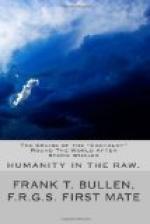Taking it all round, our visit to the Friendly Islands had not been particularly fortunate up till the time of which I spoke at the conclusion of the last chapter. Two-thirds of the period during which the season was supposed to last had expired, but our catch had not amounted to more than two hundred and fifty barrels of oil. Whales had been undoubtedly scarce, for our ill-success on tackling bulls was not at all in consequence of our clumsiness, these agile animals being always a handful, but due to the lack of cows, which drove us to take whatever we could get, which, as has been noted, was sometimes a severe drubbing. Energy and watchfulness had been manifested in a marked degree by everybody, and when the news circulated that our stay was drawing to a close, there was, if anything, an increase of zeal in the hope that we might yet make a favourable season.
But none of these valuable qualities exhibited by us could make up for the lack of “fish” which was lamentably evident. It was not easy to understand why, because these islands were noted as a breeding-place for the humpbacked whale. Yet for years they had not been fished, so that a plausible explanation of the paucity of their numbers as a consequence of much harassing could not be reasonably offered. Still, after centuries of whale-fishing, little is known of the real habits of whales, Where there is abundance of “feed,” in the case of MYSTICETA it may be reasonably inferred that whales may be found in proportionately greater numbers. With regard to the wider-spread classes of the great marine mammalia, beyond the fact, ascertained from continued observation, that certain parts of the ocean are more favoured by them than others, there is absolutely no data to go upon as to why at times they seem to desert their usual haunts and scatter themselves far and wide.
The case of the cachalot is still more difficult. All the BALAENAE seem to be compelled, by laws which we can only guess at, to frequent the vicinity of land possessing shallows at their breeding times, so that they may with more or less certainty be looked for in such places at the seasons which have been accurately fixed. They may be driven to seek other haunts, as was undoubtedly the case at Vau Vau in a great measure, by some causes unknown, but to land they must come at those times. The sperm whale, however, needs no shelter at such periods, or, at any rate, does not avail herself of any. They may often be seen in the vicinity of land where the water is deep close to, but seldom with calves. Schools of cows with recently born young gambolling about them are met with at immense distances from land, showing no disposition to seek shelter either. For my part, I firmly believe that the cachalot is so terrible a foe, that the great sharks who hover round a gravid cow of the BALAENAE, driving her in terror to some shallow spot where she may hope to protect her young, never dare to approach a sperm cow on kidnapping errands, or any other if they can help it, until their unerring guides inform them that life is extinct. When a sperm whale is in health, nothing that inhabits the sea has any chance with him; neither does he scruple to carry the war into the enemy’s country, since all is fish that comes to his net, and a shark fifteen feet in length has been found in the stomach of a cachalot.




